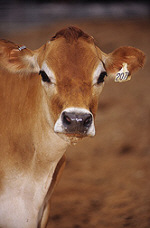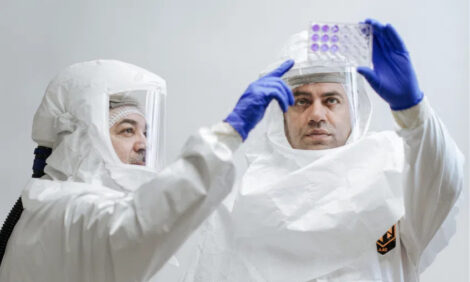



Genetic Evaluations Help Breed Better Bossies
By Sharon Durham, Agricultural Research Service, Food Animal Production, an ARS National Program, USDA. On a dairy farm, the cycle of life can be quite short. Sadly, about 8 percent of calves born do not survive beyond 48 hours and are considered stillborn.Scientists recently added calf survival as a genetic evaluation trait to a series of calculations that leads to what’s called “Lifetime Net Merit.” This genetic index for a bull predicts the profitability of his daughters.
 |
| Scientists with ARS’s Animal Improvement Programs Lab, at Beltsville, Maryland, have estimated the genetic merit of millions of cows. |
Such evaluating of dairy cattle genetic traits has allowed dairy farmers to increase milk production to all-time highs. Some of the traits evaluated are milk produced, its fat and protein content, pregnancy rate, calving ease, and now stillbirth rate.
According to Duane Norman, research leader of ARS’s Animal Improvement Programs Laboratory (AIPL), at Beltsville, Maryland, “When selecting traits for Lifetime Net Merit, the trait’s economic value, its level of hereditary influence, and the amount of variation in the trait are all taken into account.” Norman oversees a database that includes not only important yield traits, but also fitness traits that affect health, vigor, and profitability—like mastitis resistance, fertility, and longevity.
AIPL scientists have estimated the genetic merit of thousands of bulls and millions of cows from data collected since 1960 through an industry-wide dairy production testing and record-keeping system, and through breed registry societies.
“Stillbirth data is collected on-farm by dairy workers and provided to the National Association of Animal Breeders, based in Columbia, Missouri,” says AIPL geneticist Paul VanRaden. “Each trait is given a percentage of emphasis in calculation of Lifetime Net Merit. For example, milk production traits account for 46 percent; calving ease and stillbirth are combined into a calving-ability index that is valued at 6 percent.”
“Having information like this about genetic evaluation traits allows breeders to make selections that best achieve their goals,” says AIPL geneticist John Cole. “This may involve doing what’s known as ‘corrective breeding’ to strike a productive balance. For instance, a dairy farmer may mate a cow with a history of calving difficulty to a sire that’s demonstrated that his offspring are born relatively easily.”
The first national genetic evaluations for cow fertility—called “daughter pregnancy rate”—provided dairy cattle breeders with a tool for achieving desired levels of reproductive performance in today’s milking herds. They’ve used that information when choosing bulls to reduce expenses caused by low fertility.
Today, such vital genetic trait information is the basis for matings to improve the next generation of U.S. dairy cows. It’s used by about 38,000 U.S. dairy breeders and many artificial-insemination organizations, extension specialists, dairy records processing centers, and researchers here and in other countries


